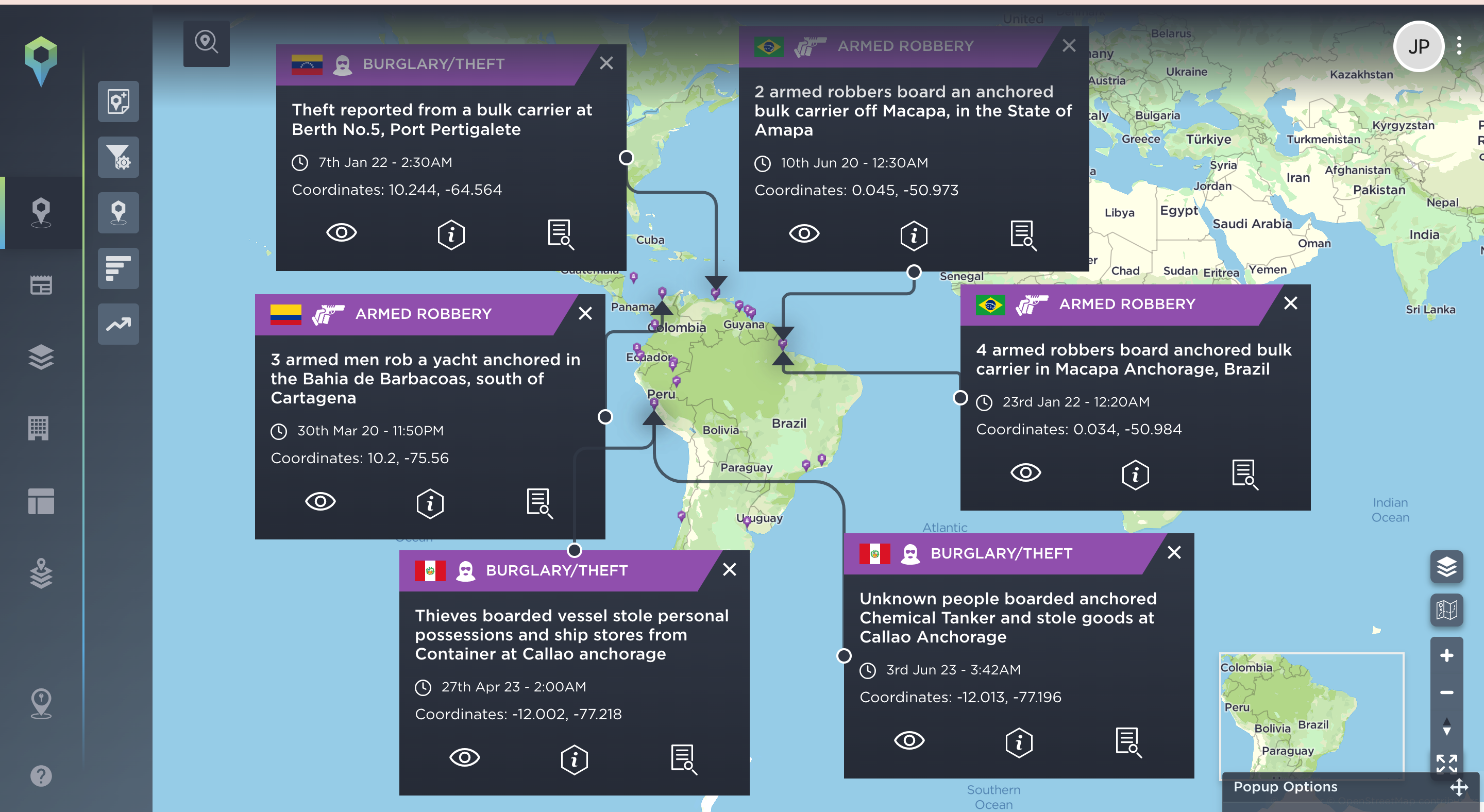Border Tensions – A Review of the Venezuela and Guyana Conflict in the Essequibo Region
December 2023 created a new chapter of the ongoing Venezuela-Guyana conflict over the Essequibo Region.
The Essequibo Region, located west of the Essequibo River, is approximately 61,600 square miles and is home to around 125,000 inhabitants. The jungled area makes up more than two-thirds of Guyana and is rich in gold, oil and other natural minerals, making it home to many international commercial operations.
This blog aims to offer a brief overview of the history of the Essequibo Region, the unfolding situation, and the potential outcomes within the near future.

Approximate outline of the Essequibo Region. Image Source: Google Maps
History of the Essequibo Region
After being acquired by default by the British Colony in 1814 as part of the ‘Anglo-Dutch Treaty’, territorial disputes over the Essequibo Region began in 1819 between the once ‘British Guiana’, now Guyana, and ‘Gran Colombia’; now Venezuela. Numerous attempts by Venezuela to annex the region led to the western boundary being defined in 1835, with the region remaining part of the British Colony.
Tensions went unmentioned for decades until the discovery of gold in 1876. Rekindling the popularity of the region, relations between the United Kingdom (UK) and Venezuela became strained. The conflict between borders was renewed, and in 1881, Venezuela proposed a new boundary line. In 1886, the British declared ownership of the land partially owned by Venezuela, completely severing all diplomatic relations. In 1894, Venezuela appealed for United States intervention; however, this was rejected.
Decades later, after continuous disputes, 1966 saw the creation of the Geneva Agreement, the same year that Guyana was granted independence from the UK. The agreement signed by both the UK and Venezuela was set to establish a peaceful solution stipulating that the parties active in the region must ‘agree to find a peaceful, practical, and satisfactory resolution to the dispute’ (1). However, Venezuela argued that the agreement ‘nullified the results of the original arbitration’ (1), and a solution was unmet.
Tensions intensified once again in 2015/2016 when oil and gas deposits were discovered in offshore sites of the territory. In 2018, Guyana asked the International Court of Justice (ICJ) to confirm the validity of the borders after Venezuela accused the UK of forging maps back in 1899, citing that the 1966 Agreement was based on fraudulence. The ICJ dismissed Venezuela’s objections concerning Guyana having sovereignty over the Essequibo Region (2).
In 2019, the United States imposed sanctions on Venezuela’s oil sector after concerns of political corruption, heavily disadvantaging the country’s claim over the region.
After adamant protestations from Venezuela, in 2020, it was ruled that an investigation would be considered to assess if the awarding of the Essequibo Region to Guyana still stands. The outcome of this was never achieved.
What is the Current Situation in the Venezeula-Guyana conflict?
The newest chapter of the Venezuela-Guyana conflict came to light in September 2023, when the Guyanese government held an auction at which oil companies bid for exploration licences in the Essequibo waters. With increasing pressure on the Venezuelan government, a deal was made with the United States to lift sanctions imposed on the country’s oil reserves in exchange for lifting the ban on the main presidential opposition; however, the ban still remains in place.
In light of the increased activity in the region, Venezuela’s current president, Nicolas Maduro, opted for a referendum to claim the region, offering citizenship to those residing in the Essequibo Region. Despite pushback from Guyana, the communities within the region, and numerous appeals to the ICJ to invalidate the request, a referendum was held in Venezuela on 3rd December 2023.
One likely reason for holding the referendum was to add political validity to the claim of the region; however, the legitimacy of the action and the outcome are seemingly questionable. With the results reflecting ‘more than 95% of voters’ (3) voting in favour, this suggested strong backing by Venezuelans. In contrast, 10.5 million votes were cast, compared to 20.7 million eligible voters within Venezuela (3).
The low turnout may cast doubts on the proportion of Venezuelans in favour of the government’s decision. Combined with the elections set for 2024, the referendum is being dubbed as a political move to ‘whip up nationalist fervour and distract from calls for free and fair elections to be held’ (4).
Following the referendum, on 7th December 2023, Maduro gave a statement demanding oil companies, such as ExxonMobil and Guyanese companies, to vacate the Essequibo Region within 90 days. The demands were ignored, and no further action has been taken and/or threatened by Venezuela.
Although there are no reports of active conflict, military movements have been reported near the region by American and Guyanese forces, with Brazilian troops reported in the bordering state of Roraima, a key access point from Venezuela to the Essequibo Region. Military drills and troop movements are likely being used as a deterrent aimed at maintaining control, as opposed to inciting conflict.

Image source: Intelligence Fusion
With Guyana securing international support, the General Secretariat of the Organisation of American States (OAS) and the Guyanese government have expressed concerns over the security of the Essequibo Region following these demands, claiming Venezuela to be an active threat. In response, on 8th December 2023, Guyana requested a security council meeting, accusing Venezuela of violating the UN Charter, leading to further discussions with the United Nations Security Council.
After a series of meetings, Guyana and Venezuela have agreed ‘to not use force to settle their dispute’ (5), supported by a joint declaration promising to remove threats made over the region. This could relate to Venezuela being urged not to take action by the ICJ, the Brazilian government condemning the use of force, and the Guyanese government opting for a peaceful solution. At present, dialogues are continuing between both countries (5).

Image source: Intelligence Fusion
The Future of the Essequibo Region
To conclude, with ongoing communications between both countries, the threat of the use of force in the Venezuela-Guyana conflict is unlikely. Although the recent referendum is being regarded as a political power move, it is likely that the region will remain under Guyanese administration until further negotiations. It is likely that past, current, and future treaties and agreements will play a crucial role in aiding the governance of the region. However, a shared solution is less likely. At the time of reporting, oil expeditions remain operational and are likely to remain in place, decreasing immediate supply chain disruptions. However, until a concrete solution is agreed upon, the threat of targeting oil vessels in the region remains active, notably by the Venezuelan Navy, as seen prior in 2018 (6).
Update from 11th January 2024
On 30th December 2023, a British military vessel was reported near the Guyanese waters, resulting in Venezuela holding military drills and deploying 6,000 troops near the territory with the threat of a military presence until the vessel leaves the area. No further military actions have been taken at the time of reporting, and it is unclear if the vessel is still present.
The unified decision to not take further action regarding the region remains in place; however, in the past 24 hours of reporting, Guyana has appealed to the United States (US) to improve its defence capacities amid the fear that Venezuela may attempt to invade the region in the future. Following the request, a US defence official has reportedly visited Guyana on the 8th and 9th of January 2024, and talks are likely underway.
No further action has been taken by Venezuela at the time of writing, and it is likely that political quarrels between Guyana and Venezuela will continue as they resume dialogue over the ownership of the Essequibo Region.
At the time of writing, the threat of invasion and/or military conflict is less likely.
References:
(1) https://en.wikipedia.org/wiki/Guayana_Esequiba
(2) https://venezuelanalysis.com/news/15740/
(3) https://www.bbc.co.uk/news/world-latin-america-67610200
(4) https://www.bbc.co.uk/news/world-latin-america-67583582
(5) https://www.bbc.co.uk/news/world-latin-america-67723936
(6) https://apnews.com/general-news-cd10f639212147f7a8552d1f34122a48



